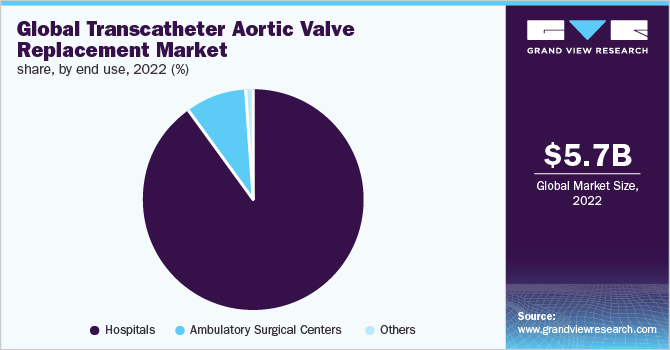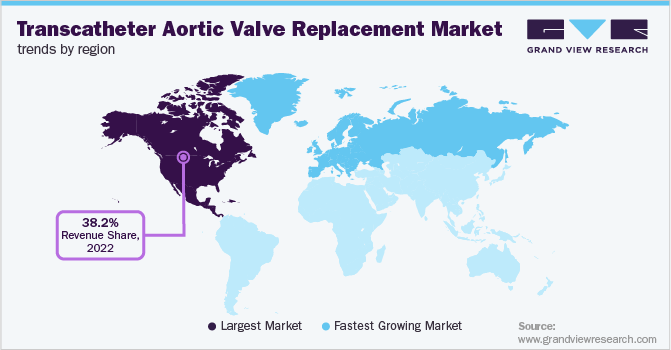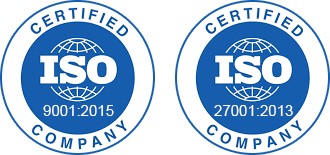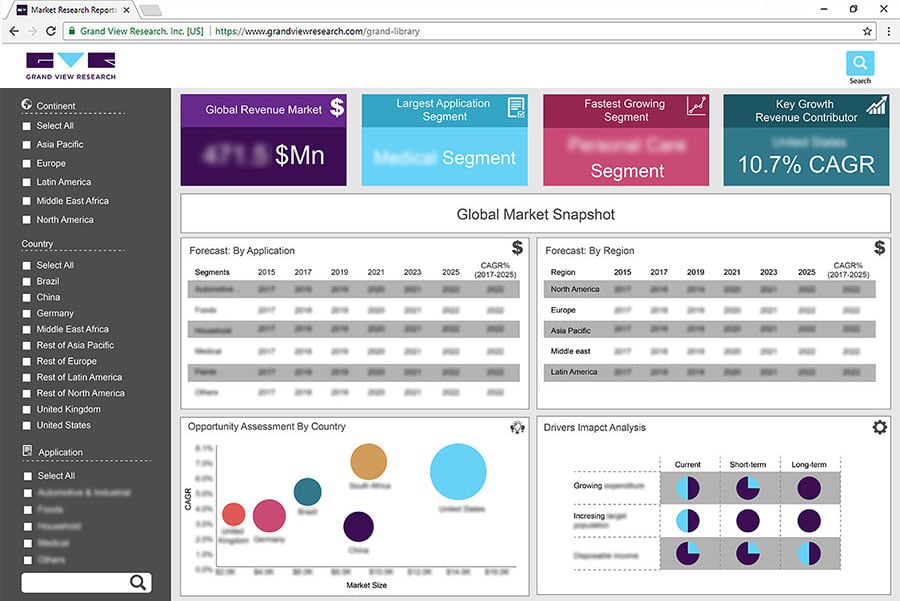- Home
- »
- Medical Devices
- »
-
Transcatheter Aortic Valve Replacement Market Report, 2030GVR Report cover
![Transcatheter Aortic Valve Replacement Market Size, Share & Trends Report]()
Transcatheter Aortic Valve Replacement Market Size, Share & Trends Analysis Report By Implantation Procedure (Transfemoral, Transapical), By Material, By Mechanism, By End Use, By Region, And Segment Forecasts, 2024 - 2030
- Report ID: GVR-2-68038-511-3
- Number of Report Pages: 120
- Format: PDF, Horizon Databook
- Historical Range: 2018 - 2023
- Forecast Period: 2024 - 2030
- Industry: Healthcare
Market Size & Trends
The global transcatheter aortic valve replacement market size was estimated at USD 6.3 billion in 2023 and is projected to grow at a CAGR of 7.2% from 2024 to 2030. Factors driving the demand for transcatheter aortic valve replacement (TAVR) include the rising prevalence of aortic valve stenosis (AS), increasing preference for minimally invasive procedures, and the expanding geriatric population. According to Cardiovascular Business Magazine, in the U.S., 92,000 TAVR valves were implanted in 2021. However, the pandemic disrupted medical device supply chains and reduced the number of medical procedures, leading to significant revenue losses for major cardiovascular device manufacturers.

The global increase in the geriatric population is another key driver for the TAVR market. Older adults are more susceptible to cardiovascular diseases, including aortic valve stenosis, which necessitates effective treatment options like TAVR. According to the World Health Organization, the proportion of the world's population over 60 years old is expected to double by 2050, reaching approximately 2.1 billion. This demographic shift means a higher number of elderly patients will require medical interventions for age-related conditions such as aortic valve stenosis. The elderly are often high-risk candidates for conventional surgical procedures, making the less invasive TAVR a more viable and safer alternative. As a result, the growing geriatric population directly correlates with increased demand for TAVR, thereby driving market growth.
In addition, technological advancements in TAVR procedures significantly contribute to market growth. Innovations in valve design, imaging techniques, and catheter technologies have improved the safety, efficacy, and accessibility of TAVR. For instance, in January 2023, Abbott revealed that the U.S. FDA approved its newest TAVR system, Navitor, for treating individuals with aortic stenosis who are at high risk for undergoing open-heart surgery. Advanced imaging technologies, such as 3D echocardiography and CT scans, enable precise planning and execution of the procedure, minimizing complications. In addition, improvements in catheter technology allow for smaller, more flexible catheters, further reducing the procedure's invasiveness. These technological advancements enhance patient outcomes and expand the potential patient pool by making TAVR a feasible option for those previously deemed ineligible. Consequently, continuous innovation is a crucial driver of the TAVR market.
Furthermore, growing clinical evidence supporting the safety and efficacy of TAVR procedures is bolstering market growth. Numerous studies and clinical trials have demonstrated that TAVR is a viable alternative to traditional surgery for high-risk patients, with comparable if not superior, outcomes. Based on this evidence, regulatory bodies such as the FDA have approved TAVR for broader patient populations, expanding its use beyond high-risk patients to those at intermediate and low risk. These approvals are crucial in increasing the adoption of TAVR as a standard treatment for aortic valve stenosis.
Market Concentration & Characteristics
The TAVR market is highly innovative. Continuous advancements in valve design, imaging technologies, and minimally invasive techniques have significantly enhanced procedural safety and efficacy. These innovations have expanded patient eligibility and improved outcomes, driving substantial growth and establishing TAVR as a crucial alternative to traditional surgical methods for aortic valve replacement.
Mergers and acquisitions in the TAVR market are moderate. Companies are strategically consolidating to enhance their technological capabilities, expand their product portfolios, and increase market reach. These activities foster innovation and drive competition, ultimately benefiting the market by improving access to advanced TAVR solutions and accelerating growth within the industry.

The impact of regulations in the transcatheter aortic valve replacement market is high. Stringent regulatory standards ensure the safety and efficacy of TAVR devices, influencing market dynamics. Regulatory approvals, such as those from the FDA and EMA, are crucial for product launches and market entry, shaping innovation and competition while ensuring that only high-quality, reliable devices are available to patients.
Product expansion in the TAVR market is high. For instance,in September 2022, Medtronic announced the launch of the Evolut FX, a self-expanding transcatheter aortic valve replacement system. The Evolut FX introduces new features to the existing Evolut platform to improve ease of use and ensure more predictable valve deployment for physicians. Companies continuously develop new and improved TAVR systems, incorporating advanced materials and technologies to enhance performance and patient outcomes. This robust product expansion drives market growth, offering a wider range of options for different patient needs and expanding the applicability of TAVR procedures.
Regional expansion in the TAVR market is high. Companies are increasingly targeting emerging markets and expanding their presence in developed regions to capitalize on the growing demand for minimally invasive cardiac procedures. This expansion involves establishing new distribution channels, forming strategic partnerships, and obtaining regulatory approvals across various regions, thereby enhancing global access to advanced TAVR technologies and driving overall market growth.
Implantation Procedures Insights
The transfemoral segment dominated this market with a revenue share of 53.80% in 2023 and is anticipated to grow at the fastest CAGR of 7.5%. This approach involves inserting the valve through the femoral artery, offering a less invasive alternative to traditional open-heart surgery. Technological advancements, improved procedural outcomes, and expanding patient eligibility criteria drive the increasing adoption of transfemoral TAVR procedures. As a result, this segment is poised for continued expansion, catering to a broader patient base seeking minimally invasive treatment options for aortic valve stenosis.
The transapical segment is experiencing robust growth. The transapical approach offers advantages such as a shorter distance between the left ventricular apex and the aortic valve, allowing greater maneuverability for operators during device implantation. Furthermore, it accommodates larger sheath diameters, facilitating smoother procedures. Various companies have innovated and introduced advanced transapical devices. For instance, Edwards Lifesciences developed the Sapien device, which utilizes a balloon-expandable system. The Sapien device boasted extensive clinical experience and was the inaugural device approved for transapical implantation by regulatory authorities, highlighting its pioneering role in advancing minimally invasive treatment options for aortic valve replacement.
Material Insights
Nitinol dominated this market and accounted for a 34.47% share in 2023. Nitinol, an alloy composed of nearly equal parts nickel and titanium, is widely used in TAVR devices due to its unique properties, such as non-magnetism, biocompatibility, flexibility, and fatigue resistance. These characteristics make it ideal for minimally invasive surgeries and implants, enhancing medical outcomes and driving segment growth. Notable TAVR devices incorporating nitinol in their frame structures include the Evolut R (Medtronic), Portico valve (St. Jude Medical, Inc.), and JenaValve (JenaValve Technology GmbH).
The cobalt chromium segment is anticipated to grow at the highest CAGR of 7.5% from 2024 to 2030. Due to its higher radiopacity and resilience compared to steel stents, which allow for a smaller mesh size and reduce the risk of thrombosis, cobalt-chromium stents also offer excellent biocompatibility. For example, Edwards Lifesciences' Sapien 3 device, the fourth generation in the balloon-expandable Sapien line, features a cobalt-chromium frame.
Mechanism Insights
The balloon-expandable segment held the largest market share of 56.83% in 2023. The balloon-expandable valve is the most widely used in TAVR procedures. Its non-repositionable, intra-annular design with a lower stent frame profile facilitates easier coronary access. In addition, the more steerable delivery method compared to self-expanding devices aids valve implantation in patients with complex vascular anatomies, such as a horizontal aorta (aortic angulation >60°). Numerous product launches are also driving the segment’s growth. For instance, in September 2022, Edwards Lifesciences received FDA approval for its Sapien 3 transcatheter aortic valve, made with materials the company claims will serve as the foundation for future heart valve implants.
The self-expandable segment is expected to grow at the fastest CAGR of 7.5% over the forecast period. Most self-expanding valves are supra-annular, providing a larger effective orifice area, lower gradients, and a reduced rate of severe prosthesis-patient mismatch (PPM). Moreover, major manufacturers continually focus on product development, driving segment growth. For instance, in August 2021, Medtronic announced FDA approval for its Evolut FX next-generation self-expanding device for patients with severe symptomatic AS. This new device features an enhanced catheter tip for easier insertion and an improved delivery mechanism with greater flexibility.
End Use Insights
Hospitals dominated this market with the largest revenue share of 90.5% in 2023, driven by the rising incidence of aortic stenosis and increased TAVR procedures. According to a Society of Thoracic Surgeons report in January 2024, nearly half of patients under 60 were receiving TAVR instead of SAVR by 2021. In addition, technological advancements in TAVR products and systems, improved healthcare infrastructure, and favorable reimbursement scenarios in both developed and developing countries are propelling segment growth. For instance, the Centers for Medicare & Medicaid Services covers TAVR for treating severe aortic stenosis under the “Coverage with Evidence Development” program.

Ambulatory surgical centers are projected to experience significant growth over the forecast period. These centers are cost-efficient and charge 45.0%-60.0% less than hospitals, with lower overhead, fixed costs, and shorter hospital stays. For instance, in June 2022, Atlas Healthcare Partners, specializing in ambulatory surgery center development and management, partnered with MedAxiom, a company focused on enhancing cardiovascular organizational performance, to launch an innovative cardiovascular-focused ambulatory surgery center business. This collaboration aims to improve cardiovascular care by expanding the availability of high-quality, patient-centered cardiovascular treatments in ambulatory surgical centers.
Regional Insights
North America dominated the transcatheter aortic valve replacement market and accounted for a 38.0% share in 2023, driven by its well-developed healthcare infrastructure and the increasing prevalence of conditions such as aortic stenosis (AS) and aortic regurgitation. The rising incidence of these disorders is expected to propel market expansion throughout the forecast period. For instance, the article "Aortic Regurgitation," published by StatPearls in April 2022, reported that the prevalence of aortic regurgitation in the U.S. ranged from 4.9% to 10.0%. Furthermore, the same source indicated that men (13.0%) are more likely to suffer from aortic regurgitation than women (8.5%).

U.S. Transcatheter Aortic Valve Replacement Market Trends
The transcatheter aortic valve replacement market in the U.S. is anticipated to grow over the forecast period, with key players such as Edwards Lifesciences, Medtronic, and Boston Scientific flourishing. These companies drive market growth through strategic developments, including innovative product launches, FDA approvals, and partnerships. For instance, in June 2022, Medline announced the launch of its TAVR drape. This latest addition to the company’s surgical drape product line is designed to streamline operations and enhance patient care in the perioperative environment. Their focus on technological advancements and expanding TAVR applications enhance procedural outcomes and expand patient access to this minimally invasive treatment.
Europe TAVR Market Trends
The transcatheter aortic valve replacement market in Europe is anticipated to experience the fastest growth during the forecast period. Several factors, including the increasing number of TAVR procedures, economic growth, regulatory impacts, and new product launches in the EU, drive this expansion. For instance, in October 2021, JenaValve Technology, Inc., a manufacturer of TAVR systems, announced the European release of the Trilogy heart valve system. Moreover, the Trilogy system received CE Mark approval for aortic stenosis (AS), offering European clinicians dual-disease therapy options.
The UK transcatheter aortic valve replacement market is influenced by various factors, including ongoing research and clinical trials. For instance, according to the NIH, in September 2022, the UK Transcatheter Aortic Valve Implantation (UK-TAVI) trial evaluated TAVR and surgical aortic valve replacement (SAVR) outcomes in patients aged over 70 with moderate operative risk. These trials are crucial for assessing safety and efficacy, shaping the adoption of TAVR in clinical practice across the UK.
The transcatheter aortic valve replacement market in Germany is expected to witness growth over the forecast period, driven by advancements in technology. Innovations such as improved valve designs and delivery systems enhance procedural outcomes and expand patient access to minimally invasive treatments. These technological advancements are crucial in shaping the future landscape of TAVR in Germany's healthcare system.
Asia Pacific TAVR Market Trends
The transcatheter aortic valve replacement market in Asia Pacificis experiencing significant growth driven by several factors. Extrapolating western prevalence data to the Indian population suggests that approximately 250,000 to 300,000 patients with aortic stenosis could potentially benefit from TAVR. This number exceeds combined estimates from Europe and North America, highlighting substantial market potential for TAVR adoption in the Asia Pacific region.
China transcatheter aortic valve replacement market is witnessing innovation with advancements in valve technologies and procedural techniques. For instance, in August 2021, Peijia Medical introduced its initial and subsequent generations of TAVR products following regulatory approval in China. These innovations enhance procedural outcomes, broaden patient eligibility, and improve accessibility to minimally invasive treatment options for severe aortic valve diseases.
The transcatheter aortic valve replacement market in Japan is expected to witness rapid growth, driven by advanced technology and evolving market factors, over the forecast. Innovations in valve designs and delivery systems enhance procedural outcomes and expand treatment options for patients with severe aortic valve diseases. These advancements are pivotal in meeting the growing demand for minimally invasive cardiovascular interventions in Japan's aging population.
Middle East and Africa Transcatheter Aortic Valve Replacement Market Trends
The transcatheter aortic valve replacement market in the Middle East and Africais influenced by the high prevalence of heart diseases, including severe aortic valve conditions. As cardiovascular diseases continue to rise in the region, TAVR procedures are becoming increasingly important for managing these conditions in patients who are at high or intermediate surgical risk. This trend underscores the growing adoption of advanced cardiovascular interventions across the Middle East and Africa.
Saudi Arabia transcatheter aortic valve replacement market is expected to grow over the forecast period by substantial healthcare investments and the expansion of hospitals equipped to perform advanced cardiovascular procedures. These investments are enhancing patient access to TAVR technologies, thereby improving treatment outcomes for individuals with severe aortic valve diseases in the region.
Key transcatheter aortic valve replacement Companies & Market Share Insights
Key players operating in the transcatheter aortic valve replacement market are undertaking various initiatives to strengthen their market presence and increase the reach of their implantation procedures and services. Strategies such as expansion activities and partnerships are key in propelling market growth.
Key Transcatheter Aortic Valve Replacement Companies:
The following are the leading companies in the TAVR market. These companies collectively hold the largest market share and dictate industry trends.
- Medtronic plc
- Abbott Laboratories, Inc.
- Boston Scientific Corporation
- Meril Life Sciences Pvt. Ltd., Inc.
- Edwards Lifesciences Corporation
- St. Jude Medical, Inc.
- JenaValve Technology, Inc
- Bracco SpA
- Transcatheter Technologies GmbH
Recent Developments
-
In March 2024, Medtronic plc announced that the U.S. Food and Drug Administration (FDA) approved the Evolut FX+ transcatheter aortic valve replacement (TAVR) system for treating symptomatic severe aortic stenosis. The new Evolut FX+ TAVR system retains the valve performance benefits of the previous Evolut TAVR platform and is designed to enhance coronary access.
-
In June 2023, egnite, Inc., a digital health company specializing in cardiovascular care, and JenaValve Technology, Inc., a developer and manufacturer of innovative TAVR systems, announced a strategic partnership. This collaboration aims to enhance understanding of the care paradigm and associated outcomes for patients with aortic regurgitation (AR).
-
In January 2024, Eisenhower Health became the first hospital in the U.S. to be designated as an Edwards Benchmark Program Case Observation Site for treating aortic stenosis in patients undergoing transcatheter aortic valve replacement.
Transcatheter Aortic Valve Replacement Market Report Scope
Report Attribute
Details
Market size value in 2024
USD 6.8 billion
Revenue forecast in 2030
USD 10.2 billion
Growth rate
CAGR of 7.2% from 2024 to 2030
Actual data
2018 - 2023
Forecast period
2024 - 2030
Quantitative units
Revenue in USD million/billion and CAGR from 2024 to 2030
Report coverage
Revenue forecast, company ranking, competitive landscape, growth factors, and trends
Segments covered
Implantation procedure, material, mechanism, end use, region
Regional scope
North America; Europe; Asia Pacific; Latin America; MEA
Country scope
U.S.; Canada; Mexico; UK; Germany; France; Italy; Spain; Denmark; Sweden; Norway; China; Japan; India; Australia; South Korea; Thailand; Brazil; Argentina; South Africa; Saudi Arabia; UAE; Kuwait
Key companies profiled
Medtronic plc; Abbott Laboratories, Inc.; Boston Scientific Corporation; Meril Life Sciences Pvt. Ltd., Inc.; Edwards Lifesciences Corporation; St. Jude Medical, Inc.; JenaValve Technology, Inc.; Bracco SpA; Transcatheter Technologies GmbH
Customization scope
Free report customization (equivalent up to 8 analysts working days) with purchase. Addition or alteration to country, regional & segment scope.
Pricing and purchase options
Avail customized purchase options to meet your exact research needs. Explore purchase options
Global Transcatheter Aortic Valve Replacement Market Report Segmentation
This report forecasts revenue growth at global, regional, and country levels and provides an analysis of the latest industry trends in each of the sub-segments from 2018 to 2030. For this study, Grand View Research has segmented the global transcatheter aortic valve replacement market report based on implantation procedure, material, mechanism, end-use, and region.
-
Implantation Procedure Outlook (Revenue, USD Billion, 2018 - 2030)
-
Transfemoral
-
Transapical
-
Transaortic
-
-
Material Outlook (Revenue, USD Billion, 2018 - 2030)
-
Nitinol
-
Cobalt chromium
-
Stainless steel
-
Others
-
-
Mechanism Outlook (Revenue, USD Billion, 2018 - 2030)
-
Balloon-expandable
-
Self-expandable
-
-
End Use Outlook (Revenue, USD Billion, 2018 - 2030)
-
Hospitals
-
Ambulatory Surgical Centers
-
Others
-
-
Regional Outlook (Revenue, USD Billion, 2018 - 2030)
-
North America
-
U.S.
-
Canada
-
Mexico
-
-
Europe
-
UK
-
Germany
-
France
-
Italy
-
Spain
-
Denmark
-
Sweden
-
Norway
-
-
Asia Pacific
-
Japan
-
China
-
India
-
Australia
-
South Korea
-
Thailand
-
-
Latin America
-
Brazil
-
Argentina
-
-
MEA
-
South Africa
-
Saudi Arabia
-
UAE
-
Kuwait
-
-
Frequently Asked Questions About This Report
b. Some key players operating in the transcatheter aortic valve replacement market include Medtronic plc; Abbott Laboratories, Inc; Boston Scientific Corporation; Meril Life Sciences Pvt. Ltd., Inc.; Edwards Lifesciences Corporation; St. Jude Medical, Inc.; JenaValve Technology, Inc.; Bracco SpA; Transcatheter Technologies GmbH.
b. Key factors that are driving the market growth include rising prevalence of aortic valve stenosis (AS), increasing demand for minimal procedures such as TAVR, and the growing geriatric population drive demand for the TAVR market.
b. The global transcatheter aortic valve replacement market size was estimated at USD 6.3 billion in 2023 and is expected to reach USD 6.8 billion in 2024.
b. The global transcatheter aortic valve replacement market is expected to grow at a compound annual growth rate of 7.2% from 2024 to 2030 to reach USD 10.2 billion by 2030.
b. North America dominated the transcatheter aortic valve replacement market with a share of 38.2% in 2023. This is attributable to its well-developed healthcare infrastructure and the increasing prevalence of disorders such as aortic stenosis and regurgitation.
Share this report with your colleague or friend.
![gvr icn]()
NEED A CUSTOM REPORT?
We can customize every report - free of charge - including purchasing stand-alone sections or country-level reports, as well as offer affordable discounts for start-ups & universities. Contact us now
![Certified Icon]()
We are GDPR and CCPA compliant! Your transaction & personal information is safe and secure. For more details, please read our privacy policy.
We are committed towards customer satisfaction, and quality service.
"The quality of research they have done for us has been excellent."





